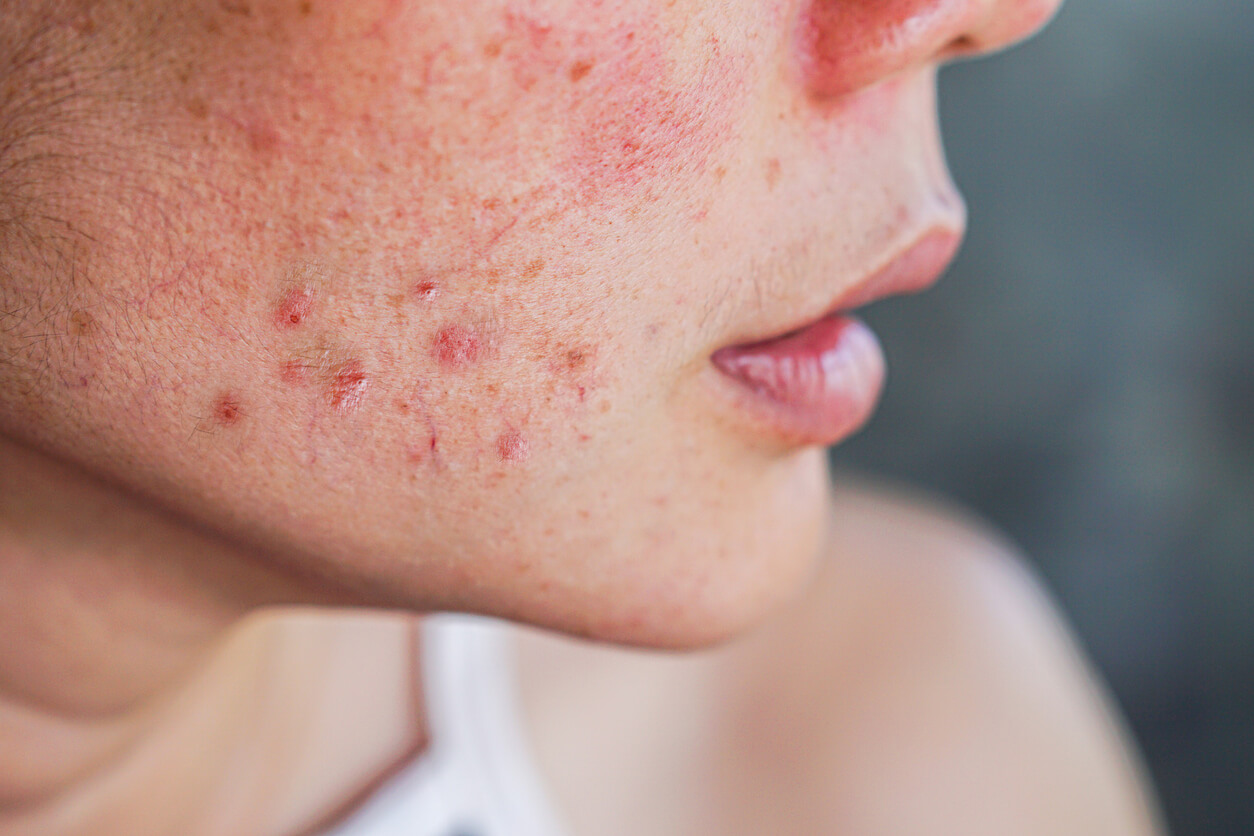Dermatological Treatments During Pregnancy: What You Should Know

There are many dermatological treatments that don’t present the specific evaluations or studies to be considered safe during pregnancy. Therefore, you must take into account what stage of pregnancy you’re in before you use certain drugs.
Dermatological treatments during pregnancy
Topical dermatological medications are one of the most prescribed, after gastrointestinal medications. It’s very important that both the patient and the doctor have perfect knowledge of the appropriate therapeutic alternatives for pregnancy in order not to put the baby’s health at risk.
Psoriasis treatment
Although some medications should be avoided, it’s possible to treat psoriasis during breastfeeding and pregnancy.
According to a publication by the American Academy of Dermatology Association, the safest therapeutic options for pregnant women include the following:
- Emollients and moisturizers: Although they’re options that don’t completely eliminate psoriasis, they protect the skin and reduce the risk of outbreaks or irritation.
- Topical corticosteroids: Corticosteroids of low or medium power shouldn’t increase the risk of causing birth defects or premature births.
- Phototherapy: This type of treatment is stronger than topical medications. In fact, only two types of phototherapy are safe in pregnant women, narrowband UVB, and broadband UVB.
Dermatological treatments that should be avoided in pregnancy are detailed below:
- Methotrexate
- Acitretin
- Tazarotene
Acne during pregnancy

The preferred therapeutic option for acne in pregnant women is a topical treatment, as many oral drugs are contraindicated at this stage. For example, isotretinoin, tazarotene, and spironolactone can cause serious birth defects.
The American Academy of Dermatology Association describes that antibiotics commonly used for acne, such as clarithromycin and azithromycin, appear to be safe during pregnancy. However, it’s best to stop taking doxycycline, minocycline, or tetracycline by the 15th week of pregnancy.
In addition, the use of laser and light therapies is considered relatively safe for pregnant women. Similarly, it’s always recommended to consult with your dermatologist or obstetrician before starting any acne treatment.
Skin infections in pregnant women
Skin infections are those in which germs (viruses, bacteria, or fungi) infect the skin tissue and penetrate its thickness. You can get them any time your skin is broken, whether it’s from a tattoo, cut, prick, piercing, bite, or insect stings or bites.
1. Bacterial infections
It’s important to try to avoid prescribing antibiotics to pregnant women unless there’s strong evidence of an ongoing bacterial infection. In fact, the use of antibacterials during pregnancy must outweigh the risks, which differ according to the trimester of pregnancy.
In general, cephalosporins, penicillins, and macrolides are considered safe, while fluoroquinolones and tetracyclines are contraindicated at this stage.
2. Viral infections
Viral infections are quite common during pregnancy and the herpes simplex virus is one of the most frequent.
Pregnant women experiencing a recurrence or a first clinical episode can be treated with valganciclovir or acyclovir at the accepted and recommended doses. However, the use of these drugs is at the discretion of the specialist and the particular case.
Treatment with valganciclovir and acyclovir from week 36 reduces the frequency of vertical transmission and the clinical manifestations of the disease.
3. Fungal infections
Fungal infections are quite frequent during pregnancy, as hormonal changes can modify the pH of the skin and mucous membranes. The drugs indicated to treat fungal infections are presented as ointments, creams, or pastes.
The following products can be used at any time during pregnancy, without this representing a risk of gestational complications:
- Clotrimazole
- Miconazole
- Terconazole
Oral presentations aren’t recommended in pregnant women, especially during the first trimester of pregnancy.
Drug Risk Classification

The classification used by the Food and Drug Administration (FDA) is the most well-known and used in the United States. In it, the risks of medications during pregnancy are classified as follows:
- A: The studies carried out don’t show any risk to the fetus.
- B: The results with animals show some degree of risk, while in people they don’t.
- C: Risks to the fetus can’t be ruled out.
- D: There’s real evidence of risk to the fetus.
- X: There are proven fetal risks, so they’re absolutely contraindicated during pregnancy.
The safety of dermatological treatments in pregnancy
In conclusion, although many medications have minimal risk during pregnancy and lactation, some medical professionals decide not to prescribe any medication at this stage. Furthermore, both the specialist and the pregnant woman should know which drugs can be administered safely and which should be completely avoided during this period.
There are many dermatological treatments that don’t present the specific evaluations or studies to be considered safe during pregnancy. Therefore, you must take into account what stage of pregnancy you’re in before you use certain drugs.
Dermatological treatments during pregnancy
Topical dermatological medications are one of the most prescribed, after gastrointestinal medications. It’s very important that both the patient and the doctor have perfect knowledge of the appropriate therapeutic alternatives for pregnancy in order not to put the baby’s health at risk.
Psoriasis treatment
Although some medications should be avoided, it’s possible to treat psoriasis during breastfeeding and pregnancy.
According to a publication by the American Academy of Dermatology Association, the safest therapeutic options for pregnant women include the following:
- Emollients and moisturizers: Although they’re options that don’t completely eliminate psoriasis, they protect the skin and reduce the risk of outbreaks or irritation.
- Topical corticosteroids: Corticosteroids of low or medium power shouldn’t increase the risk of causing birth defects or premature births.
- Phototherapy: This type of treatment is stronger than topical medications. In fact, only two types of phototherapy are safe in pregnant women, narrowband UVB, and broadband UVB.
Dermatological treatments that should be avoided in pregnancy are detailed below:
- Methotrexate
- Acitretin
- Tazarotene
Acne during pregnancy

The preferred therapeutic option for acne in pregnant women is a topical treatment, as many oral drugs are contraindicated at this stage. For example, isotretinoin, tazarotene, and spironolactone can cause serious birth defects.
The American Academy of Dermatology Association describes that antibiotics commonly used for acne, such as clarithromycin and azithromycin, appear to be safe during pregnancy. However, it’s best to stop taking doxycycline, minocycline, or tetracycline by the 15th week of pregnancy.
In addition, the use of laser and light therapies is considered relatively safe for pregnant women. Similarly, it’s always recommended to consult with your dermatologist or obstetrician before starting any acne treatment.
Skin infections in pregnant women
Skin infections are those in which germs (viruses, bacteria, or fungi) infect the skin tissue and penetrate its thickness. You can get them any time your skin is broken, whether it’s from a tattoo, cut, prick, piercing, bite, or insect stings or bites.
1. Bacterial infections
It’s important to try to avoid prescribing antibiotics to pregnant women unless there’s strong evidence of an ongoing bacterial infection. In fact, the use of antibacterials during pregnancy must outweigh the risks, which differ according to the trimester of pregnancy.
In general, cephalosporins, penicillins, and macrolides are considered safe, while fluoroquinolones and tetracyclines are contraindicated at this stage.
2. Viral infections
Viral infections are quite common during pregnancy and the herpes simplex virus is one of the most frequent.
Pregnant women experiencing a recurrence or a first clinical episode can be treated with valganciclovir or acyclovir at the accepted and recommended doses. However, the use of these drugs is at the discretion of the specialist and the particular case.
Treatment with valganciclovir and acyclovir from week 36 reduces the frequency of vertical transmission and the clinical manifestations of the disease.
3. Fungal infections
Fungal infections are quite frequent during pregnancy, as hormonal changes can modify the pH of the skin and mucous membranes. The drugs indicated to treat fungal infections are presented as ointments, creams, or pastes.
The following products can be used at any time during pregnancy, without this representing a risk of gestational complications:
- Clotrimazole
- Miconazole
- Terconazole
Oral presentations aren’t recommended in pregnant women, especially during the first trimester of pregnancy.
Drug Risk Classification

The classification used by the Food and Drug Administration (FDA) is the most well-known and used in the United States. In it, the risks of medications during pregnancy are classified as follows:
- A: The studies carried out don’t show any risk to the fetus.
- B: The results with animals show some degree of risk, while in people they don’t.
- C: Risks to the fetus can’t be ruled out.
- D: There’s real evidence of risk to the fetus.
- X: There are proven fetal risks, so they’re absolutely contraindicated during pregnancy.
The safety of dermatological treatments in pregnancy
In conclusion, although many medications have minimal risk during pregnancy and lactation, some medical professionals decide not to prescribe any medication at this stage. Furthermore, both the specialist and the pregnant woman should know which drugs can be administered safely and which should be completely avoided during this period.
All cited sources were thoroughly reviewed by our team to ensure their quality, reliability, currency, and validity. The bibliography of this article was considered reliable and of academic or scientific accuracy.
- Can a woman treat psoriasis while pregnant or breastfeeding? [Internet] Disponible en: https://www.aad.org/public/diseases/psoriasis/treatment/stage/pregnant
- Is any treatment safe to use during pregnancy? [Internet] Disponible en: https://www.aad.org/public/diseases/acne/derm-treat/pregnancy
- Rogan SC, Beigi RH. Treatment of Viral Infections During Pregnancy. Clin Perinatol. 2019 Jun;46(2):235-256. doi: 10.1016/j.clp.2019.02.009. Epub 2019 Mar 28. PMID: 31010558.
- Straface, G., Selmin, A., Zanardo, V., De Santis, M., Ercoli, A. y Scambia, G. (2012). Infección por el virus del herpes simple en el embarazo. Enfermedades infecciosas en obstetricia y ginecología , 2012 , 385697. https://doi.org/10.1155/2012/385697
- FDA Pregnancy Categories. [Internet] Disponible en: https://chemm.hhs.gov/pregnancycategories.htm
This text is provided for informational purposes only and does not replace consultation with a professional. If in doubt, consult your specialist.








